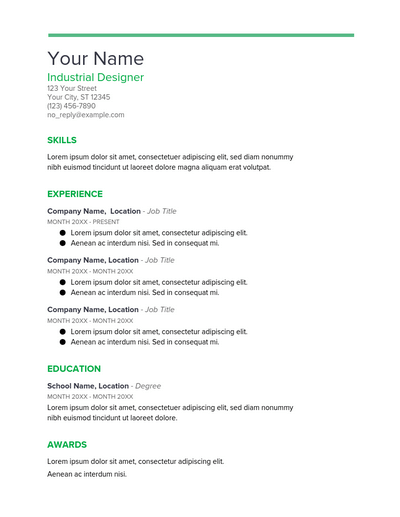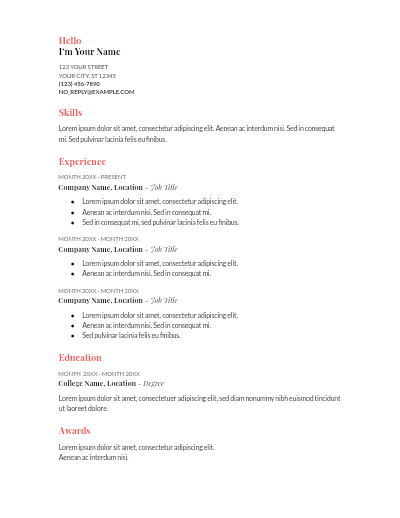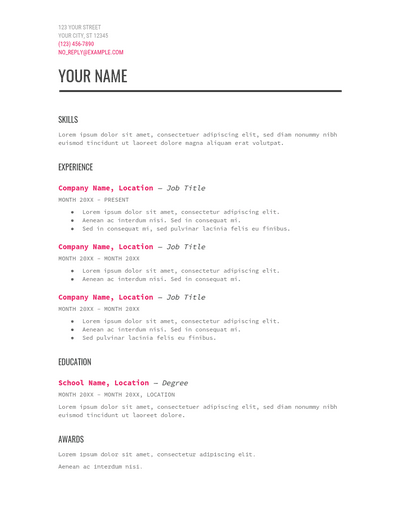We’re often asked, “How do you write an entry-level
If you’re here, you’ve probably never written a
The good news is that you can write your entry-level
Whether you’re a recent graduate or a candidate with professional experience, you’ll find everything you need to create a beginner
At MatchBuilt, we are dedicated to helping entry-level job seekers write winning resumes. For more tips on
Why It’s Important to Have an Effective Resume
A
- Sells your different skills, qualities, relevant coursework, and relevant work experience
- Shows your eligibility for a particular job
- It acts as a path to subsequent steps, such as interviews and prescreening
Top Tips on How to Write an Entry-level Resume
When writing an entry-level
1. Put Your Contact at the Top of Your Resume
Include your contact information at the top of the
Your location address isn’t mandatory on your resume. However, you may consider including it if the job you’re applying for is near your home. If it’s located far away, including your location is not advisable. You risk getting disqualified if the company feels that they need to help you relocate. And, if they don’t have a relocation budget, they might choose someone who lives nearby.
If you’ve to include your location in such a scenario, then the best thing to do is include that you plan to move from your current location to the city where the company is based.
Mimi from Starkflow, a company that helps you recruit top remote talent, gave the following advice concerning writing your contact information in a
Your name and contact information should always be at the top of your
resume . You must include your phone number, a professional-sounding email address, and LinkedIn URL.
2. Tailor the Resume to the Job You Are Applying For
You need to modify your
By tailoring your
On top of that, it shows that you understand the hiring manager’s needs and are ready to help the company achieve its goals.
To make your
Mimi also added that you need to
Take a close look at the job description and prepare your
resume for the specific job. You want to match the language as closely as possible regarding particular keywords.Most companies use applicant tracking systems (or ATSs)—programs that scan your
resume looking for keywords found in the job description and forward the resumes with the most matches to a hiring recruiter. So be cautious and list keywords exactly as they appear in the job description.
3. Emphasize Your Education
A candidate’s education is one of the most important things recruiters check when reviewing resumes. They want to hire a candidate whose educational background fits their open role. Having relevant education can set you apart from other candidates, increasing your chances of getting hired.
When writing about your education, you should do it chronologically and clearly. But first, you need to review the job specifications again to determine the education levels you must include in the
Some of the things you should include in the education section are:
- The schools you attended
- Field of study
- The degree you have
- Your majors or minors
- Any applicable coursework, academic recognition, and other educational achievements
You don’t have much working experience when writing an entry-level
If you had vast experience, you’d make this section very brief and instead focus on your working experience. You’d also write the education section with Dean’s List honors, if applicable, at the bottom of your
4. Showcase Your Skills
Displaying your skills in a
When writing the skills section, include both the hard and soft skills. Hard skills, such as hand-eye coordination and technological skills, are quantifiable and teachable. Soft skills are more interpersonal skills, including communication, team building, and leadership.
These skills, including soft skills, may also be helpful if a recruiter uses a tracking system when scanning resumes. The tracking systems search for specified skills in the form of keywords, and if your
Remember to be honest. A job specification stating that a candidate should possess specific skills shouldn’t make you say that you have the skills while you don’t. You might be asked to demonstrate your prowess in such skills or explain how you achieved them, and that would lead you into trouble after a recruiter realizes you weren’t honest.
5. State Your Experience
You may not have worked full-time before as an entry-level candidate, meaning you don’t have much experience. If you’ve ever held any part-time job, include it in the experience section. Don’t mind whether it’s relevant to the job you’re applying for or not. Previous employment shows potential employers that you’ve some working experience and can complete tasks. Other things you can include in the experience section include:
A. Volunteer Work
If you’ve ever participated in any volunteer work, include the details in the work experience section. Volunteer work also counts, especially if you were actively engaged in a specific role.
B. Projects
Are there projects you undertook as part of your coursework? Include them, too, in this section. Projects can showcase your skills and interests, especially when applied to the position you have applied for.
C. Internships or Apprenticeships
If you’ve been on an internship or apprenticeship program, state that in the work experience section. Even if the internship was in a different field from what you’re applying for, it could increase the chance of being hired.
D. Organizations
If you have participated in an organization, that also counts as experience. It even gets better if you have been in a leadership position. It discloses your leadership skills and experiences working with others.
Kirk Hazlett, an adjunct professor with Curry College, gave the following insights regarding what to write if you don’t have much working experience.
If you are working, say, as a part-time waiter, don’t list your duties as “wait tables; clean tables.” Highlight “customer service,” “problem-solving,” and “attention to detail.” And, if you’ve been doing this job for a while, point out your longevity.
If you have been/are involved in a team-leader role in high school or college sports activities, highlight that aspect of your activity. Don’t say “played high school soccer.” Say (IF you did!) “As team captain led us to a series of victories.”
List your employment (if you’ve had more than one job over the years) in reverse chronological order, starting with what you’re doing now and working backward. Have a clear start and stop dates for each job.
6. Use Keywords
Like optimizing your LinkedIn profile, you’ll want to do the same for your
In this case, keywords refer to individual words or phrases related to a particular job specification. These can be a candidate’s skills, credentials, abilities, and qualities.
Now that you know the importance of using keywords in a
You can also get them by searching the “about us” section of the company’s website. You’ll learn what they value most and use the same as your keywords.
For example, if the company emphasizes creativity as one of the skills they value most, use that as one of the keywords in your
Mary Guirovich, author of “God’s Not Done with You: How to Advance Your Career,” commented on
Write your
resume for the recruiter- then optimize it for the applicant tracking system (ATS). While it’s important to include keywords from the job description to get past the tracking system, yourresume is ultimately reviewed and evaluated by a human. If you focus on stuffing in keywords and tricking the system, yourresume will likely not appeal to the recruiter.Tailor your
resume for each position and naturally use the keywords and job title from the job description. Applicant tracking systems count the number of times keywords exist but don’t try to trick the system by adding in a keyword section or putting text in white, thinking you will trick the system because the ATS converts all of your text to one color and Live in Abundance.
Searching for keywords can be time-consuming and demanding but worth the trouble. It increases the chances of your
7. Include a Summary of the Resume
Include a summary of your
To write the summary, describe who you are as a candidate. This is the best approach for entry-level job seekers.
Including some of your future career goals, such as where you want to be in the future, is also allowed. When you get some experience later, you can talk about your career achievements or past roles.
Although a
Mary Guirovich agreed with this and shared the following comments.
Show your personality- When the recruiter reads your
resume , you want them to see you as a person, not just a list of skills. Adding aresume summary is a great way to stand out and show your personality, excitement, and enthusiasm to do the position and work for the company.For example, you are in marketing and applying for a job with a company that sells pet supplies. A summary is a great opportunity for you to share your love of pets and your desire to work for a brand you have shared values with.
Additionally, it briefly describes your skills, experience, and objectives, allowing you to highlight your most important assets. That makes it easier for the recruiter to scan your profile and see whether it fits the job description when you have the right qualifications, increasing your chances of getting noticed.
8. Format Your Resume Properly
You may have impressive skills and experience, but a recruiter won’t look at your
Here are some tips to guide you on how to format a
A. Use a Professional Font
The kind of font you use in your
B. Use Correct Margins
1″ margins are the most commonly used in resumes, especially for entry-level job seekers. Since you may not have a lot information in your
C. Use Headers
Use headers for every section in your
Using flashy, attention-capturing graphics when writing a
Mary Guirovich had this to say concerning
Keep the Formatting Simple: Applicant tracking systems prefer simple-to-read fonts and formats, and the recruiters agree. Avoid using graphs, tables, hyperlinks, images, headers, footers, logos, columns, uncommon section headings, templates, borders, and fancy fonts.
Stick with a standard
resume format over a functionalresume layout, as ATS has a harder time reading functionalresume formats without dates and often through them out.Use bold text, common headlines, and bullet points, limit to one page and leave white space. Last but not least is the file type a Microsoft Word Doc or PDF is most widely accepted by tracking systems.
Kirk from Curry College also had something to say about formatting.
Keep your
resume to one page, neatly laid out, and in readable font size. I usually advise a 12-point font size, no less. Don’t get fancy with design. Use a simple, easy-to-read, easy-to-follow layout. Yourresume will be one of the hundreds of resumes that the HR person or hiring manager will review. Make it memorable. More important, make it relevant!
9. Proofread the Resume Carefully
With many people looking for work, you must put in a lot of effort and make no mistakes when applying for a job to stand out. After writing your
And proofreading does not only involve checking whether there are any typos or sentence construction issues. It also involves checking whether you have included the correct information, tailored the
After doing all that, read it word by word, line by line. This makes it easy to spot missing words, misused words, double words, etc. Check the contact information too, and ensure it’s accurate. A simple mistake in the contact information section can make it impossible for a recruiter to contact you. You don’t want that after all the effort you’ve put into writing your
In addition, it’s also advisable to have someone proofread the
Entry-Level Resume Examples & Templates with Google Docs
Below are entry-level
To quickly find examples and resumes on Google Docs, launch the Google Docs app (create an account if you haven’t already). Then, from the home page, click on “Template Gallery” and scroll down until you find the
Each entry-level Google Doc
You can easily add or replace any section you wish. So, if you’re unhappy about the skills section being so high up, just replace it with a professional summary or a career objective.
1. Google Doc “Spearmint” Entry Level Resume Example Template
2. Google Doc “Serif” Entry Level Resume Example Template
3. Google Doc “Coral” Entry Level Resume Example Template
4. Google Doc “Swiss” Entry Level Resume Example Template
5. Google Doc “Modern Writer” Entry Level Resume Example Template
Action Word and Descriptive Synonyms for Resume
When creating your
Action Word Synonyms for Responsible
- Spearheaded
- Implemented
- Accountable
- Amenable
- Answerable
- Liable
Action Word Synonyms for Experience
- Accomplished
- Capable
- Competent
- Mature
- Professional
- Qualified
- Seasoned
- Skillful
Action Word Synonyms for Managed for Resume
- Coordinated
- Administered
- Supervised
- Mentored
- Trained
- Coached
- Guided
- Organized
Action Word Synonyms for Developed
- Implemented
- Expanded
- Founded
- Invented
- Launched
- Established
- Generated
- Initiated
Action Word Synonyms for Worked
- Communicated
- Mediated
- Teamed
- Collaborated
- Participated
- Cooperated
- Partnered
- Contributed
Action Word Synonyms for Utilize
- Apply
- Adopt
- Deploy
- Employ
- Exert
- Handle
- Mobilize
- Operate
- Promote
- Put to Use
- Restore
- Revive
- Specialize in
Final Thoughts on How to Write an Entry-level Resume
When writing an entry-level
Additionally, format your








